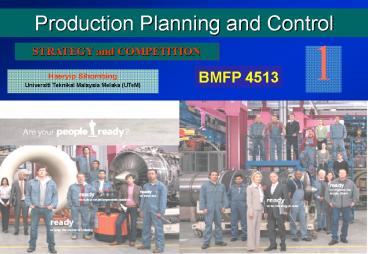Project Management 3e. - Gray and Larson PowerPoint PPT Presentation
Title: Project Management 3e. - Gray and Larson
1
(No Transcript)
2
Topic Areas of PPC Course
- Aggregate Planning
- Scheduling
- Supply Chain
- Simulation
- Lean Six Sigma
- Management of Information System
- Prerequisite topics
- Forecasting
3
Functional Areas of the Firm
4
What is Strategy ?
- Strategy is a common vision that unites an
organization, provides consistency in decisions,
and keeps the organization moving in the right
direction
5
Time Horizons for Strategic Decisions
- 1. Long Term Decisions ( gt year) ? Strategic
decision - Locating and Sizing New Facilities
- Finding New Markets for Products
- Mission Statement meeting quality objectives
- 2. Intermediate Term Decisions (weeks or month)
- Forecasting Product Demand
- Determining Manpower Needs
- Setting Channels of Distribution
- Equipment Purchases and Maintenance
- 3. Short Term Decisions (hours or days) ?
Tactical decision - Purchasing
- Shift Scheduling and Maintenance
- Inventory Control
6
The Elements of Strategy
7
Decision Horizons of Manufacturing Strategy
8
History of Production and OM
- Major Thrust of the Industrial Revolution
1850-1890 - Factories tended to be small. Boss had total
control. Little regard for workers safety or
workers rights. - Production Manager Position. 1890-1920.
- Frederick Taylor champions the idea of
scientific management. - As complexity grows specializations take hold.
- Inventory Control Manager
- Purchasing Manager
- Scheduling Supervisor
- Quality Control Manager etc.
9
GLOBALIZATION COMPETITION
- Global competition is heating up to an
unprecedented degree. It appears that several
factors favor the success of some industries in
some countries - For example
- Germany printing presses, luxury cars, chemicals
- Switzerland pharmaceuticals, chocolate
- Sweden heavy trucks, mining equipment
- United States personal computers, software,
entertainment - Japan automobiles, consumer electronics
10
Porters Thesis
- Famed management guru, Michael Porter, has
developed a theory to explain the determinants of
national competitive advantage. These include - Factor Conditions
- (Land, Labor,Capital, etc.)
- Demand Conditions
- (local marketplace may be more
sophisticated/demanding than world marketplace) - Related and Supporting Industries
- Firm Strategy, structure, rivalry
- (e.g. Germans are strong technically, Italian
family structure, Japanese management methods)
11
Time-Based Competition
Time-based competitors focus on the bigger
picture, on the entire value-delivery system.
They attempt to transform an entire organization
into one focused on the total time required to
deliver a product or service. Their goal is not
to devise the best way to perform a task, but to
either eliminate the task altogether or perform
it in parallel with other talks so that over-all
system response time is reduced. Becoming a
time-based competitor requires making
revolutionary changes in the ways that processes
are organized (Blackburn(1991). Being not
only the first to market but the first to volume
production as well gives a firm a decided
advantage.
12
How Do Firms Differentiate Themselves from
Competitors?
- Low Cost Leaders Some examples include
- WalMart and Costco in Retailing
- Korean automakers (Hyundai, Kia, etc.)
- e machines personal computers
- High Quality (and price) Leaders. Ex
- Mercedes Benz automobiles
- Rolex Watches
- (some firms do both Chevrolet and Cadillac)
13
Understand TradeoffsExample Made-to-Order Pizza
14
Some Dimensions of Competition
- Re-engineering of the Business Process
- Streamlining process
- JIT Deliveries
- Cutting waste
- Time-based competition
- Shortening time to delivery
- Competing on Quality
15
Business Process Re-engineering
- The process of taking a cold hard look at the way
that things are done. Term coined by Hammer and
Champy in their 1993 book. - Classic Example IBM Credit Corporation. The
process had been broken down to a series of
multiple steps, each having substantial delays.
Approval required from 6 days to 2 weeks. The
process was re-engineered so that a single
specialist would handle a request from beginning
to end. The result was that turnaround time was
slashed to an average of 4 hours!
16
Just-In-Time
JIT is a production control system that grew
out of Toyotas kanban system. It is a philosophy
of production control (also know as lean
production) that attempts to reduce inventories
to an absolute minimum. It has become pretty much
a standard way of thinking in many industries
(especially the automobile.) We will discuss
JIT and its relationship to MRP in next session
course.
17
The Product Life-Cycle Curve
18
The Product/Process Matrix
19
So you have an idea what others do and you have
a business idea
20
OPERATION AS A SYSTEM
21
DECISION MAKING
22
A Framework for Manufacturing Strategy
23
PRODUCTION SYSTEM
24
CAPACITY
- Level of capacity
- Size of capacity changes
- Handling excess demand
- Hiring/firing workers
- Need for new facilities
25
FACILITIES
- Best size for facility
- Large or small facilities
- Facility focus
- Facility location
26
HUMAN RESOURCES
- Skill levels required
- Degree of autonomy
- Policies
- Profit sharing
- Individual or team work
- Type of supervision
- Levels of management
- Training
27
QUALITY
- Target level
- Measurement
- Employee involvement
- Training
- Systems needed to ensure quality
- Maintaining quality awareness
- Evaluating quality efforts
- Determining customer perceptions
28
SOURCING
- Degree of vertical integration
- Supplier selection
- Supplier relationship
- Supplier quality
- Supplier cooperation
29
OPERATIONS PRIORITIES
- Cost
- Quality
- Delivery Flexibility
- Delivery Speed
- Delivery Reliability
- Coping with Changes in Demand
- Flexibility and New Product Introduction Speed
30
The TRANSFORMATION PROCESS
31
MANAGEMENT IN e-BUSINESS
32
TYPES OF B2B TRANSACTIONS
33
GLOBALIZED THE BUSINESS
34
COMPETITION
35
STRATEGIC DECISIONS IN OPERATIONS
36
Example WAL-MART
37
Product Vs. Process Vs. Technology
38
Matrix
39
ISSUES and TRENDS
40
The END

